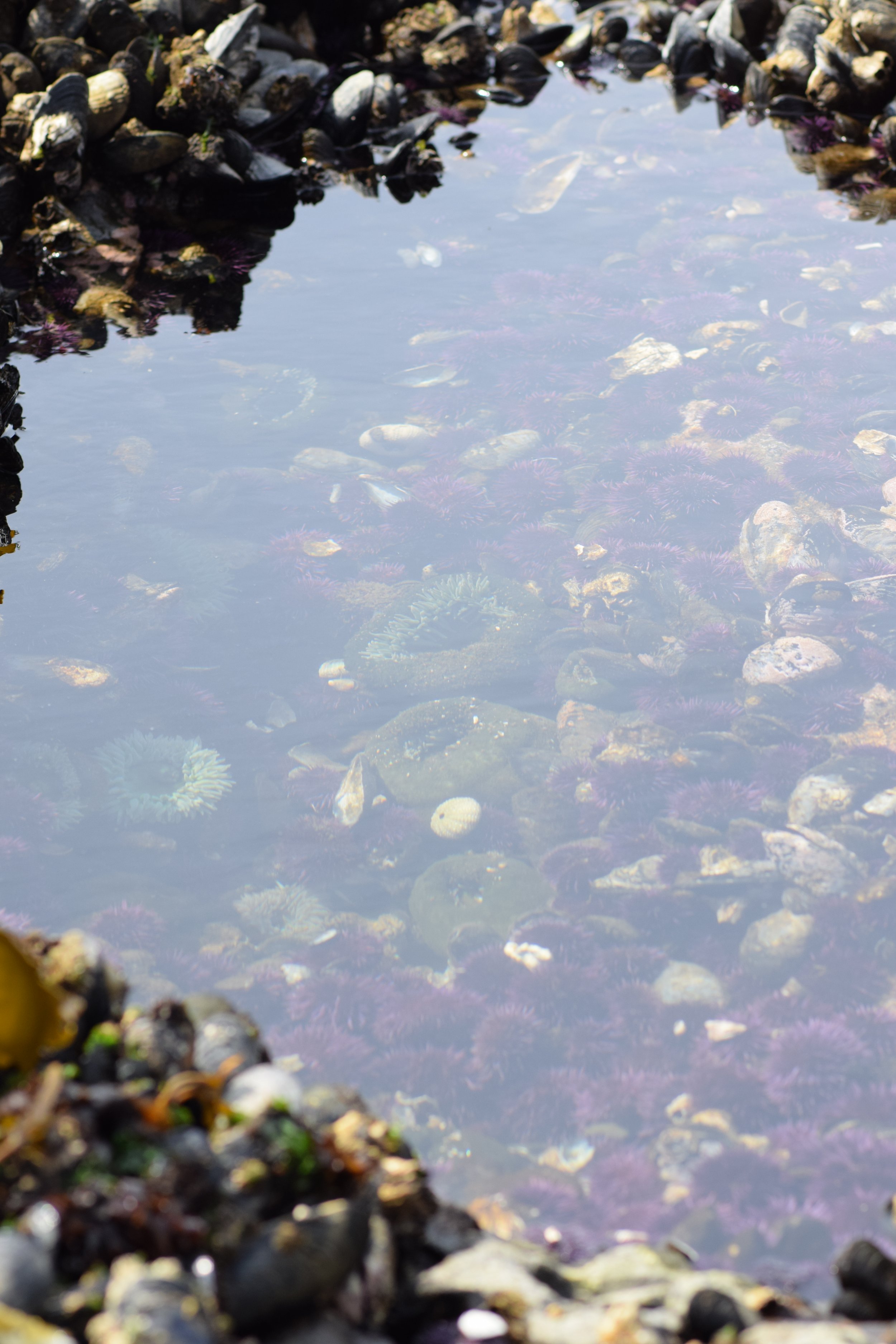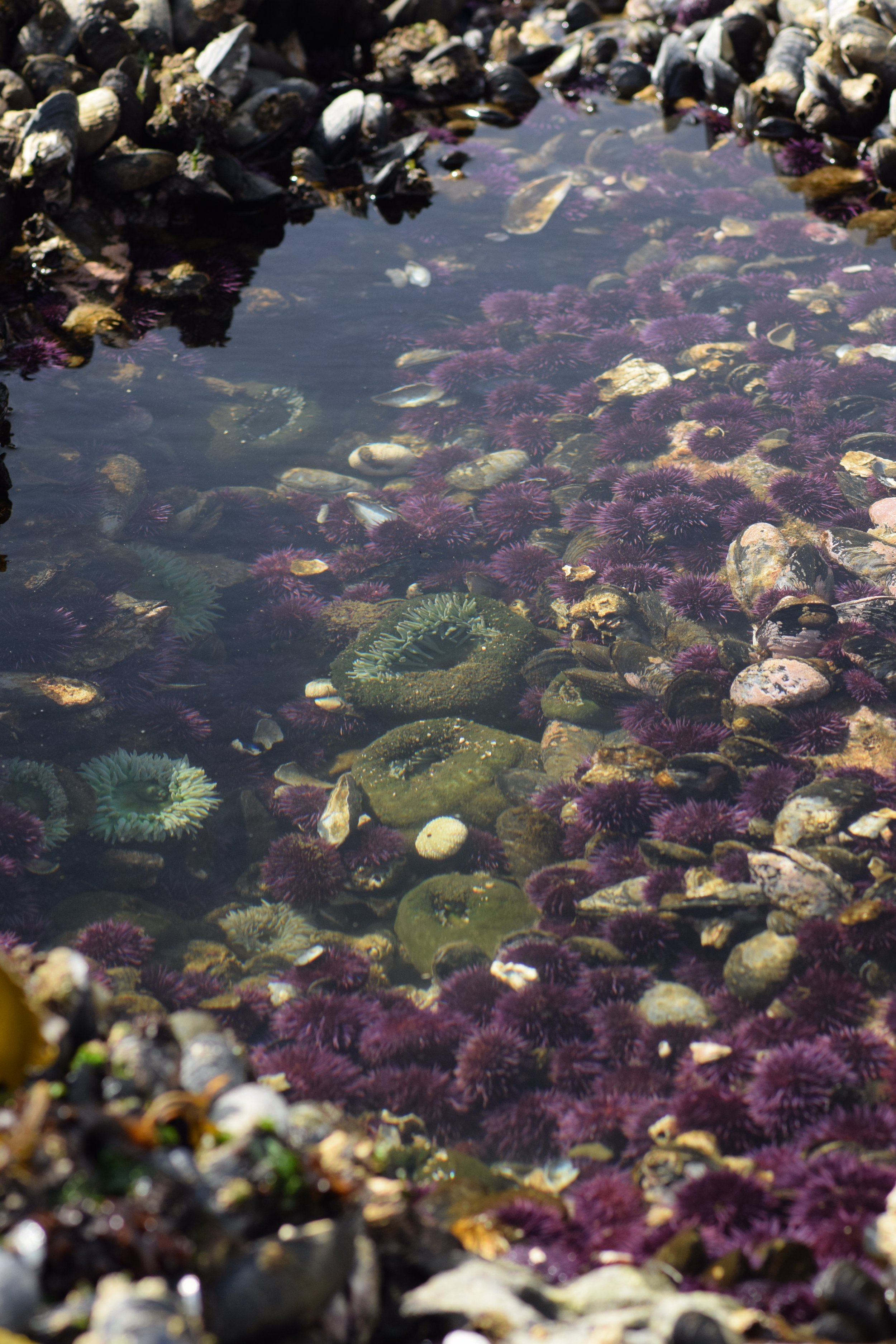by Serena Tierra, Assistant Educator
Sea stars, Photo: Serena Tierra
BEFORE YOU GO
1) Consult a tide chart
Visit tides.gc.ca to find the tides for the beach you plan to visit. The Sidney tidal station provides the tides for our nearby Glass Beach. Visit during the lowest tides possible. Look for negative tides to access the greatest diversity; negative tides don’t come around very often.
Plan to arrive at least an hour before peak low tide so you have plenty of time for exploring.
2) Prepare
Supplies to bring:
Sunscreen, hat, & waterproof shoes with good traction
Water to drink and snacks
Polarized sunglasses
ID guides
Camera
First aid kit
AT THE BEACH
1) Getting started
Rinse your hands (but not with soap!)
Dip your hands into the ocean (not a tidepool) or if you have access, use a tap or sink to remove soap, sanitizer, and other harmful products before touching animals. Keep your hands wet while you are touching — this will make it less stressful for the animals.
Be gentle
A great rule for touching is using only your pinky finger. Avoid spending too much time handling each individual animal; some animals shed body parts or use other defensive mechanisms when they are scared or threatened.
Go slow
For your safety and animal safety, try not to rush; you don’t want to step on fragile animals or overlook camouflaged ones. To find hidden animals, stop in one place for a few minutes, next to a tide pool or a big rock, and bend down to get a better view. Your shadow may startle crabs and sculpins but they will come back out of hiding if you stay still. The longer you watch, the more animals you will notice. Moving slowly will minimize your risk of slipping.
Be mindful of moving or lifting rocks
Only move rocks smaller than your head. When you are done carefully replace them in the same spot and the same orientation; some species are adapted to live under the rock and others on top. Also be careful so that nothing is crushed or left uncovered.
2) Interacting safely
Touching with one finger and wet hands is a general rule that applies for many species you will encounter, but there are some exceptions:
CRABS – When picking up small shore crabs, cup your hands and stay close to the ground. If you drop the crab or it climbs out, it won’t have far to fall. For larger crabs, hold them from the back so they can’t pinch you, but still stay low to the ground.
FISH – You may not expect to see fish on the beach, but tidepool sculpins, gunnels, and clingfish can all live in the intertidal zone. Often they are found in tide pools or under rocks. Sometimes you will see them out of the water — they are okay! These fish can survive out of the water and don’t need to be moved. This is one group of animals we should avoid touching. They have a protective coating of mucus on their skin that can be damaged.
Black katy chiton, Photo: Serena Tierra
ANCHORED ANIMALS – This includes limpets, snails, chitons, anemones, sea stars, and more. These animals have strong feet holding them to the rocks so they aren’t removed by waves or predators. This also helps them hold onto water while the tide is out. Do not remove animals from the rocks. This can cause damage and make it harder for them to survive until high tide.
Aggregating anemones, Photo: Serena Tierra
CLOSED ANEMONES – One of the most common species in this area is the aggregating anemone. They close up when they are exposed to hold in water until the tide comes back in. When they are touched, by a hungry predator or curious human, they jet out the water in defense. This puts them at risk of drying out, especially on hot summer days. Because of this, it’s best not to touch any closed anemones.
3) Photography
If you find something you can’t identify, take pictures. Photos from multiple angles and of any structures you notice can be valuable for identification. It also helps to include an object for scale. This can be any common item with a consistent size – coins, keys, pens, even your hand! A macro lens for your camera or phone is useful here for small animals and details. Another helpful tool is a polarizing filter. They can help remove glare from the water, giving you a clearer picture of what is in the tide pool.
Tide pool image without and with polarizing filter, Photos: Serena Tierra
AFTER YOUR ADVENTURE
1) Identifying your finds
Now that you’ve documented your favorite finds, it’s time to identify them. Guidebooks are a great place to start, especially when you have a rough idea of what you’re looking at. You can also ask one of our Educators by bringing pictures to the Centre or messaging them to our social media channels.
There are also a number of online resources where you can connect with others for help with identifications. Post pictures, locations and any notable observations on the iNaturalist app or website. The site assists with identifications and online experts confirm them.
There are local naturalist groups on Facebook groups that allow you to crowdsource an ID — Field Naturalists of Vancouver Island and Pacific Coast Tide Pool and Beachcombing Identification and Appreciation are my personal favorites.
2) Souvenirs
Resist the temptation to bring souvenirs home with you. A general rule is remove human-created objects, but natural ones should stay at the beach. Here is what we mean.
DO take:
Garbage – “Take 3 for the Sea” is a staff favorite. Pick up THREE pieces of garbage each time you visit a beach.
Seaglass – This is a favorite beach find. As it is human-created, it’s okay to remove from the beach. Glass Beach in Sidney (just south of the aquarium) is known for having endless seaglass.
Avoid taking:
Rocks – They create a habitat for animals to live in and hide under.
Shells – They provide homes for hermit crabs and other animals. Shells and rocks also break down, returning needed components to the natural system.
Live animals – It’s damaging to the ecosystem and the individual animals, especially if you release them in a different place. You also require a collection permit to keep any live animals.
UPCOMING LOW TIDE EVENTS:
July 12, 9:00am-11:00am – Glass Beach, Sidney
July 14, 11:00am-1:00pm – Patricia Bay, North Saanich
August 10, 9:00am-11:00am – Patricia Bay, North Saanich
August 11, 9:30am-11:30am – Glass Beach, Sidney






